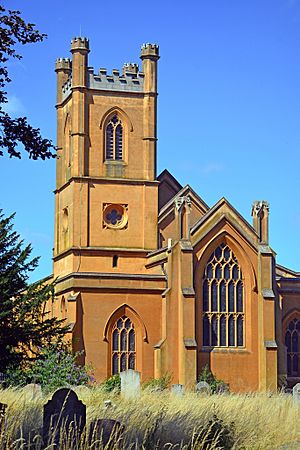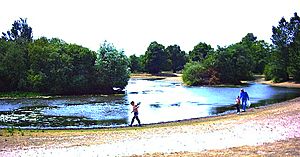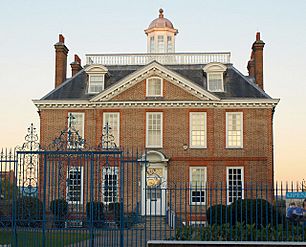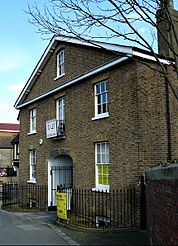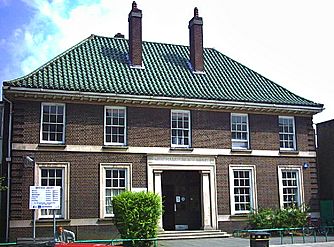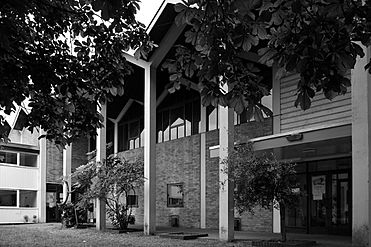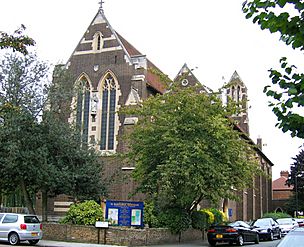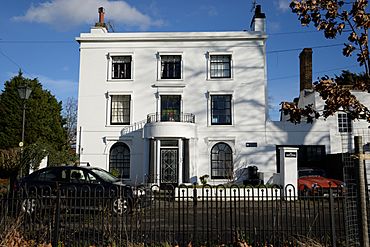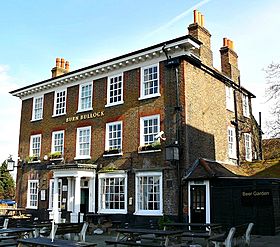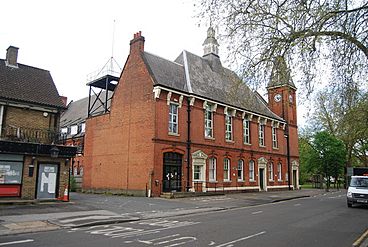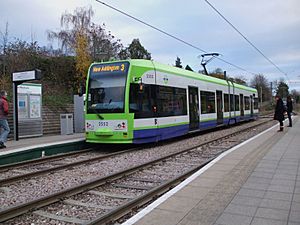Mitcham facts for kids
Quick facts for kids Mitcham |
|
|---|---|
 Mitcham Clocktower. Built in 1898 and renovated in 2016 |
|
| Population | 63,393 (2011 Census) |
| OS grid reference | TQ285685 |
| London borough | |
| Ceremonial county | Greater London |
| Region | |
| Country | England |
| Sovereign state | United Kingdom |
| Post town | MITCHAM |
| Postcode district | CR4 |
| Dialling code | 020 |
| Police | Metropolitan |
| Fire | London |
| Ambulance | London |
| EU Parliament | London |
| UK Parliament |
|
| London Assembly |
|
Mitcham is a lively area in Southwest London, England. It's part of the London Borough of Merton. Mitcham is about 7 miles (11.6 km) southwest of Charing Cross, a famous spot in central London.
Once a small village in Surrey, Mitcham is now mostly a place where people live. It's known for its large open space, Mitcham Common. Mitcham has been a settlement for a very long time. It has useful places like Mitcham Library and the historic Mitcham Cricket Green. In 2011, Mitcham had a population of over 63,000 people.
Contents
Where is Mitcham?
Mitcham is located in the eastern part of the London Borough of Merton. It's close to other well-known areas. These include Streatham, Croydon, Norbury, Morden, Sutton, Wimbledon, and Tooting.
The River Wandle flows along the southwest side of the town. The original village area is in the west. A big part of the boundary is covered by Mitcham Common. Some areas, including parts of Mitcham Common, are in the CR0 postcode.
A Look at Mitcham's Past
The name "Mitcham" comes from Old English. It means "big settlement." Before the Romans and Saxons arrived, it was a Celtic settlement. There's even evidence of an old hill fort in the Pollards Hill area.
Discoveries of Roman graves and a well show that Romans lived here. An Anglo-Saxon graveyard was found on the north bank of the River Wandle. It's the largest one found so far. Many items from it are now in the British Museum. Experts believe Mitcham was one of the first places settled by the Anglo-Saxons.
The Church of England parish church of St Peter and St Paul is very old. It dates back to the early Kingdom of England. Most of the church was rebuilt in 1819–1821. However, its original Saxon tower is still standing.
Mitcham in the Domesday Book
The Domesday Book of 1086 mentions Mitcham as Michelham. It was a small farming community. About 250 people lived in two small villages. These were Mitcham (now Upper Mitcham) and Whitford (Lower Green).
The Domesday Book shows Mitcham had 8 hides and 1 virgate of land. It also had a small mill and lots of meadow land.
Royal Visits and Lavender Fields
Queen Elizabeth I visited Mitcham at least five times. Famous people like John Donne and Sir Walter Raleigh also lived here. Mitcham became a popular place for wealthy people.
It was known for its many lavender fields. The fresh air was thought to be good for health. People even moved here to escape the plague.
Mitcham was famous for its lavender and peppermint oils. In 1749, two local gardeners, John Potter and William Moore, started a company. They made toiletries from herbs and flowers grown nearby. Lavender is still important to Mitcham. It's on the Merton Council's coat of arms. It's also on the badge of the local football team, Tooting & Mitcham United F.C..
Growth and Industry
When factories started to appear, Mitcham quickly grew into a town. Many farms were replaced by new buildings. Some reminders of its farming past still exist. These include Mitcham Common and Arthur's Pond.
Mitcham became a center for industry along the River Wandle. Factories made snuff, copper, flour, iron, and dye. By 1750, Mitcham and nearby Merton Abbey were major centers for printing calico cloth. Asprey, a company selling luxury goods, started here in 1781. William Morris also opened a factory on the Wandle. The old Liberty silk-printing works are now a craft village.
The Surrey Iron Railway, the world's first public railway, was built here in 1803. After the railway closed in the 1840s, industries changed. Growing plants gave way to manufacturing. Companies making paint, varnish, linoleum, and fireworks moved in. This led to the population doubling between 1900 and 1910.
Modern Mitcham
In 1829, Miss Mary Tate gave land and money to build almshouses. These were homes for twelve poor widows or single women. The buildings were designed in a Tudor style.
Mitcham became a borough on September 19, 1934. During World War II, German bombing targeted Mitcham due to its industries. Mitcham Common was even farmed to help with the war effort.
After the war, areas like Eastfields, Phipps Bridge, and Pollards Hill were rebuilt. This provided more affordable housing. The largest council housing project is Phipps Bridge Estate.
Mitcham Cricket Green is very famous. It might be the world's oldest cricket ground in continuous use. It's also home to the world's oldest club, Mitcham Cricket Club. A road separates the pavilion from the pitch, which is quite unusual!
Local stories say Mitcham has the oldest fair in England. People believe Queen Elizabeth I granted it a special permission. However, this has never been proven.
Mitcham's Population Growth
| 19th Century | 20th Century | ||
|---|---|---|---|
| 1801 | 3,466 | 1901 | 14,903 |
| 1811 | 4,175 | 1911 | 29,606 |
| 1821 | 4,453 | 1921 | 35,119 |
| 1831 | 4,387 | 1931 | 56,859 |
| 1841 | 4,532 | 1941¹ | war |
| 1851 | 4,641 | 1951 | 67,269 |
| 1861 | 5,078 | 1961 | 63,690 |
| 1871 | 6,498 | 1971 | 60,608 |
| 1881 | 8,960 | 1981 | 57,158 |
| 1891 | 12,127 | 1991² | n/a |
|
|||
| source: UK census | |||
Green Spaces in Mitcham
Mitcham has a huge green space called Mitcham Common. It covers 460 acres (186 hectares) and has several ponds and buildings.
The Windmill Trading Estate buildings have been around since 1782. The Mill House Ecology Centre and The Harvester pub are near an old windmill. Parts of this windmill still exist today.
Seven Islands pond is the biggest pond on the Common. It was created in the 1800s from gravel digging. The newest pond, Bidder's pond, was made in 1990. It's named after George Parker Bidder.
Famous Buildings
- The Canons: This house was built in 1680. It was owned by the Cranmer family until 1939. The name comes from an old priory from the 12th century. The pond and dovecote (built in 1511) are even older than the house!
- Eagle House: Built in 1705, this house is in the Dutch style. It was built for Dr. Fernando Mendes, a doctor to King Charles II.
- Mitcham Common Windmill: An old windmill from 1806.
- Old Mitcham Station: This building was once a merchant's home. It's possibly the oldest railway station building in the world.
- The Tate Almshouses: Built in 1829 by Mary Tate to help the poor.
- Mitcham Vestry Hall: Part of this building now holds the Wandle Industrial Museum.
- Mitcham Public Library: Opened in 1933.
- Elm Lodge: This house from 1808 was home to a village doctor. The artist Sir William Nicholson also lived here for a short time.
- Mitcham Court: The main part of this building was built in 1840. Julius Caesar Czarnikow, a sugar merchant, lived here. He gave the village a new horse-drawn fire engine.
- Renshaw's factory: A marzipan factory that moved to Mitcham in 1924. It was featured in old British news films. The area where it stood is now called Renshaw Corner.
- Poulters Park: Home to Mitcham Rugby Union Football Club.
- Imperial Fields: The home ground for Tooting & Mitcham United F.C..
- Mitcham Methodist Church: Designed by Edward Mills and built in 1958–59. It's considered an important example of church architecture.
- St Barnabas Church: Built in a gothic style, its foundation stone was laid in 1913. It's still an active Anglican church.
- The White House, Mitcham: This 18th-century house was updated in 1826. A village doctor, Dr. A.C. Bartley, lived here.
- The Burn Bullock: This old pub was originally called the King's Head Hotel. It's named after Burnett Bullock, a famous local cricket player.
- The White Hart public house: Mitcham's oldest recorded inn. It was rebuilt in 1749–50 after a fire. Stagecoaches used to start from its yard.
Famous People from Mitcham
Many interesting people have connections to Mitcham:
- Ramz (rapper) – a singer and rapper.
- John Donne – a famous poet and churchman from the 1600s.
- James Chuter Ede – a politician who was an MP for Mitcham. He later became the Home Secretary.
- Michael Fielding and Noel Fielding – comedians known for The Mighty Boosh.
- Mike Fillery – a professional football player.
- M.I.A. – a singer, songwriter, and rapper.
- Peter D. Mitchell – a Nobel prizewinner, born in Mitcham in 1920.
- Slick Rick – an American rapper, born in Surrey.
- Alex Stepney – a former Manchester United footballer. He won the European Cup in 1968.
- Herbert Strudwick – a cricket wicket-keeper.
- William Allison White – received the Victoria Cross for bravery.
Population and Diversity
Mitcham is a diverse area. The population of the Mitcham and Morden parliamentary area is over 103,000 people.
Ethnic Groups
Mitcham is home to people from many different backgrounds:
- White British
- Irish
- Other White groups
- Mixed/Multiple Ethnic Groups (like White and Black Caribbean)
- Asian (including Indian, Pakistani, Bangladeshi, Chinese, and other Asian groups)
- Black/African/Caribbean (including African, Caribbean, and other Black groups)
- Other Ethnic Groups (like Arab)
Religions
People in Mitcham follow many different religions:
- Christian
- Muslim
- Hindu
- Buddhist
- Sikh
- Jewish
- Many people also state they have no religion or prefer not to say.
Gender
The population is almost evenly split between females and males.
Getting Around Mitcham
Mitcham has good transport links.
Train Stations
There are two train stations:
- Mitcham Junction
- Mitcham Eastfields
Mitcham Eastfields was the first new suburban station in the area in 50 years. Both stations have trains run by Govia Thameslink Railway. You can travel to places like Sutton, Epsom, London Victoria, and St Albans.
Tramlink
The Tramlink system also serves Mitcham. There are four tram stops in the area:
- Mitcham Junction
- Mitcham
- Belgrave Walk
- Phipps Bridge
Trams offer direct services to Wimbledon, Croydon, Beckenham Junction, and Elmers End. You can also reach New Addington with a change at Croydon.
Bus Services
London Buses operate many bus services in Mitcham. This includes night buses to central London.
Coach Services
National Express coaches also stop in Mitcham. These services connect London Victoria to places like Eastbourne, Brighton, Worthing, Bognor Regis, and Gatwick Airport.
 |
Colliers Wood & Wimbledon | Tooting | Streatham |  |
| Morden | Pollards Hill, Norbury & Thornton Heath | |||
| Sutton & Rose Hill | Hackbridge | Beddington & Croydon |
See also
 In Spanish: Mitcham para niños
In Spanish: Mitcham para niños



